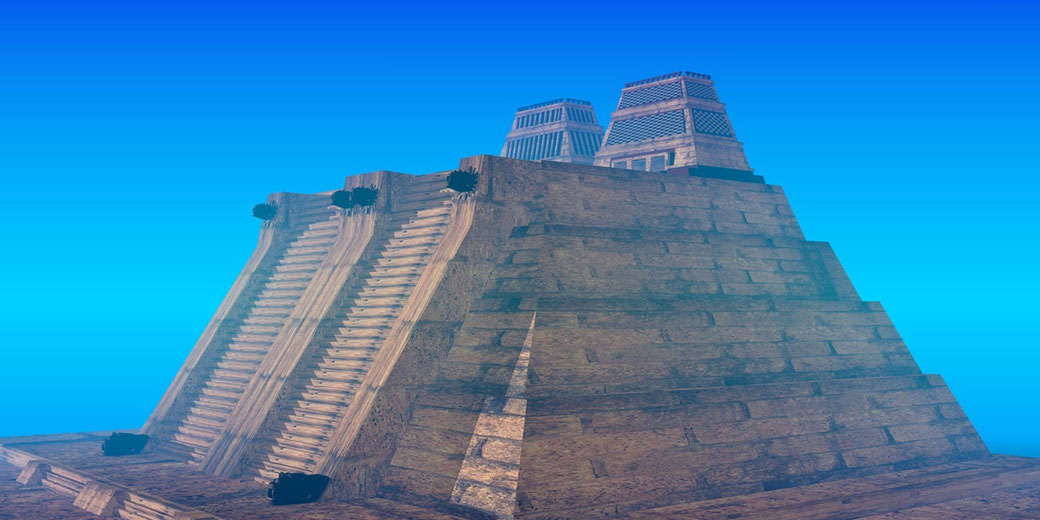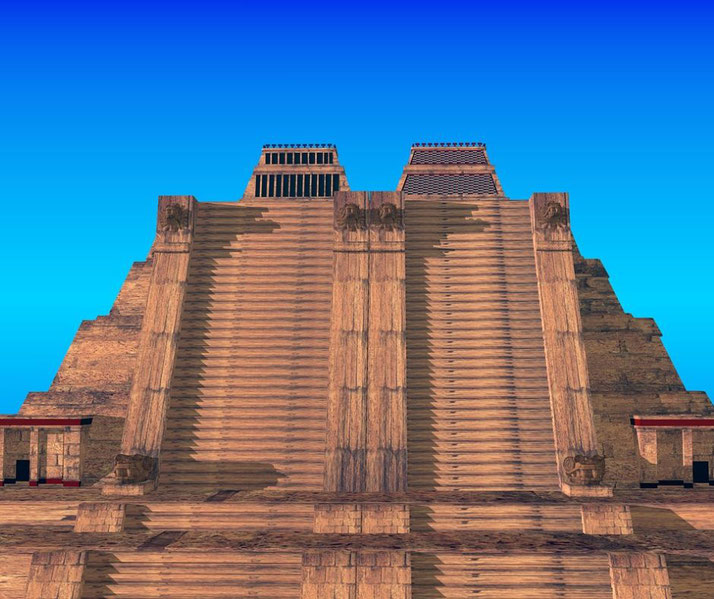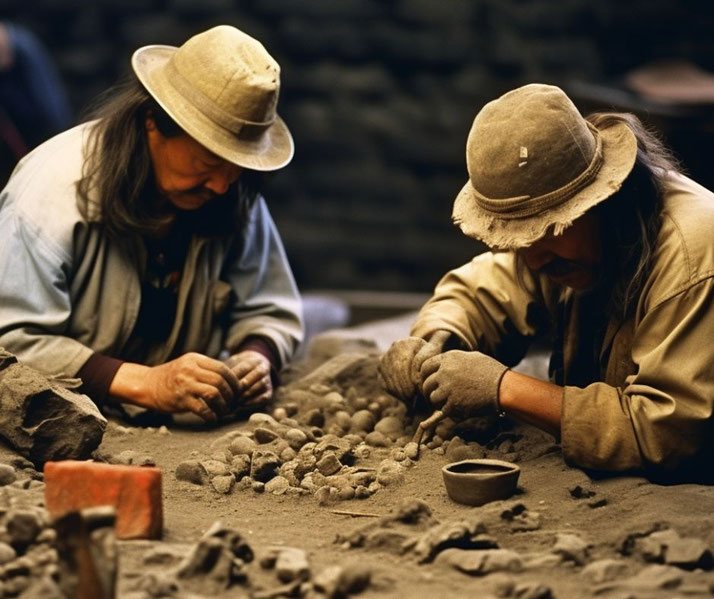The Templo Mayor: The gruesome epicentre of the Aztec cult of human sacrifice

The Templo Mayor, or the 'Great Temple', was the religious and ceremonial epicenter of the Aztec Empire, a civilization that flourished in the Valley of Mexico from the 14th to the 16th century.
Today, it stands as an archaeological marvel, offering a window into the complex system of Aztec culture, religion, and history.
The Templo Mayor was more than just a monumental structure; it was the embodiment of the Aztec worldview. It was here that the Aztecs paid homage to their gods, conducted their most sacred rituals, and asserted their power and prestige.
The temple's grandeur and complexity reflect the sophistication of Aztec society and its deep-rooted spiritual beliefs.
Why the Aztecs built the Templo Mayor
The Aztec Empire, also known as the Triple Alliance, was a powerful Mesoamerican civilization that dominated the Valley of Mexico from the 14th to the 16th centuries.
The empire was a complex political, social, and economic system that included a number of city-states, with Tenochtitlan, the city that housed the Templo Mayor, as its capital.
The Aztecs were renowned for their architectural prowess, agricultural innovations, and intricate social hierarchy.
However, it was their religious beliefs that played a central role in shaping their society.
The Aztecs were deeply spiritual, with a pantheon of gods that governed every aspect of their lives, from agriculture and warfare to childbirth and death.
These gods were appeased through elaborate rituals and ceremonies, many of which were conducted at the Templo Mayor.
The Templo Mayor was built in Tenochtitlan, an island city in Lake Texcoco, around 1325.
According to Aztec mythology, this was the spot where the Aztecs saw an eagle perched on a cactus, devouring a snake - a sign from their patron god, Huitzilopochtli, that they should settle there.
The temple was constructed at the heart of the city, symbolizing the axis mundi, or the center of the universe, in Aztec cosmology.
Over the centuries, the temple was expanded and rebuilt several times, each iteration reflecting the changing fortunes and aspirations of the Aztec Empire.
By the time of the Spanish conquest in the 16th century, the Templo Mayor had evolved into a grand complex with twin temples dedicated to Huitzilopochtli, the god of the sun and war, and Tlaloc, the god of rain and agriculture.
How did the Aztecs build the Templo Mayor?
The Templo Mayor was a marvel of Aztec engineering and architectural design. Its construction began around 1325, and it underwent seven major expansion phases, each corresponding to a different ruler's reign.
Each new phase involved building over and around the existing structure, resulting in a layered effect that archaeologists have since been able to study in detail.
The temple was designed as a large pyramid with twin temples at the top, one dedicated to Huitzilopochtli, the god of the sun and war, and the other to Tlaloc, the god of rain and agriculture.
This dual structure reflected the Aztec's dualistic worldview, which saw the universe as a balance of opposing forces such as life and death, day and night, and dry and wet seasons.
The pyramid was built using a core of rubble and earth, faced with carefully cut and fitted stones.
It was adorned with intricate carvings and sculptures, many of which depicted the gods to whom the temple was dedicated.
The pyramid was accessed by a series of steep staircases that led to the twin temples at the top.
The Templo Mayor was part of a larger sacred precinct that included other temples, altars, and ceremonial platforms.
The entire complex was surrounded by a coatepantli, or snake wall, which was decorated with carvings of snakes and other sacred symbols.
The temple's location in the center of Tenochtitlan was significant. It was believed to be the spot where the Aztecs saw the sign from their patron god to settle, and it was also the symbolic center of the universe in Aztec cosmology.
The temple's orientation was carefully planned to align with the cardinal directions, and its design incorporated elements that represented the different layers of the universe, from the underworld to the terrestrial realm to the heavens.

The religious rituals conducted at the Templo Mayor
The Templo Mayor was the spiritual heart of the Aztec Empire, a place where the divine and the earthly realms intersected. It was a site of profound religious significance, embodying the Aztecs' complex cosmology and their deep reverence for the gods.
Huitzilopochtli was the patron god of the Aztecs, believed to guide them on their journey from their mythical homeland of Aztlan to the Valley of Mexico.
The Aztecs believed that Huitzilopochtli required nourishment in the form of human sacrifice to continue his journey across the sky, a belief that led to the practice of ritual human sacrifice on a large scale at the Templo Mayor.
Tlaloc, on the other hand, was associated with life-giving elements like rain and fertility.
Rituals dedicated to Tlaloc often involved offerings of seeds, flowers, and other symbols of fertility, as well as the sacrifice of children, whose tears were seen as symbolic of rain.
The Templo Mayor was the site of numerous religious festivals and ceremonies throughout the year, each designed to appease the gods and ensure the continued prosperity of the Aztec Empire.
These rituals involved music, dance, processions, and the offering of gifts to the gods, including precious objects, animals, and human sacrifices.
The religious significance of the Templo Mayor extended beyond its role as a place of worship. It was also a symbol of Aztec power and legitimacy, a physical manifestation of their divine mandate to rule.
The grandeur of the temple, the richness of its offerings, and the scale of its rituals were all designed to reinforce the Aztecs' status as the chosen people of the gods.
The dramatic destruction of the temple
The Templo Mayor, along with much of the Aztec capital of Tenochtitlan, was destroyed following the Spanish conquest of the Aztec Empire in the 16th century.
The Spanish, led by Hernán Cortés, arrived in Mexico in 1519. They were initially received peacefully by the Aztec emperor, Moctezuma II, who may have believed Cortés to be a representative of the god Quetzalcoatl.
However, relations quickly deteriorated, and in 1521, the Spanish laid siege to Tenochtitlan.
The siege lasted for several months, during which the city was heavily damaged by warfare and disease.
When the Spanish finally captured the city, they systematically destroyed many of the Aztec's religious buildings, including the Templo Mayor.
This was done both to demoralize the Aztecs and to eradicate their religious practices, which the Spanish viewed as pagan and barbaric.
The Templo Mayor was not just destroyed but also built over. The Spanish used the stones from the temple to construct their own buildings, including the Mexico City Metropolitan Cathedral.
This was a common practice during the Spanish colonization of the Americas, as it allowed the Spanish to physically and symbolically assert their dominance over the indigenous populations.
How Templo Mayor was suddenly rediscovered
The Templo Mayor lay hidden beneath the bustling streets of Mexico City for centuries, its existence largely forgotten.
It wasn't until the 20th century that this ancient Aztec temple was rediscovered, marking a significant turning point in our understanding of Mesoamerican history.
The first hint of the Templo Mayor's existence came in 1790 when a colossal stone disk depicting the dismembered goddess Coyolxauhqui was unearthed during construction work in Mexico City's central square.
However, the true significance of this find was not recognized at the time, and it would be nearly two centuries before the Templo Mayor was rediscovered.
The breakthrough came in 1978 when electrical workers stumbled upon a monolithic stone carving while digging a trench.
Recognizing the potential significance of the find, archaeologists were called in, and excavation work began.
The carving turned out to be another depiction of Coyolxauhqui, similar to the one found in 1790, and its discovery led archaeologists to the ruins of the Templo Mayor.
Since then, the Templo Mayor has been the site of extensive archaeological excavations.
These excavations have revealed the temple's complex layered structure, with each layer corresponding to a different phase of construction.
They have also unearthed a wealth of artifacts, from monumental sculptures to delicate ornaments, each offering new insights into Aztec culture and religion.
The excavation of the Templo Mayor has been a monumental task, requiring careful planning and meticulous attention to detail.
The temple's location in the heart of Mexico City has posed significant challenges, as has the need to preserve the site's fragile structures and artifacts.
Despite these challenges, the work has yielded invaluable results, transforming our understanding of the Aztec civilization and its legacy.

The greatest archaeological finds from the Templo Mayor
The Templo Mayor is a treasure trove of Aztec art and iconography, with thousands of artifacts unearthed since its discovery.
These artifacts, ranging from monumental sculptures to delicate ornaments, offer invaluable insights into the Aztecs' religious beliefs, social structures, and artistic traditions.
One of the most significant finds at the Templo Mayor is the Coyolxauhqui Stone. This massive monolithic disk depicts the dismembered goddess Coyolxauhqui.
According to Aztec mythology, Coyolxauhqui was killed by her brother Huitzilopochtli after she attempted to murder their mother, Coatlicue.
The stone was placed at the base of the Huitzilopochtli side of the temple, symbolizing the god's victory over his sister.
Other notable artifacts include a series of large stone sculptures known as the "Teotihuacan-style" warriors, a reference to the artistic style of the earlier Teotihuacan civilization.
These sculptures, which depict warriors with elaborate headdresses and shields, were likely used as architectural elements in the temple.
The Templo Mayor has also yielded a wealth of smaller objects, including ceramic vessels, jade ornaments, obsidian blades, and shells.
Many of these objects were used as offerings to the gods and were buried in caches throughout the temple.
These offerings provide a glimpse into the Aztecs' ritual practices and their relationships with other Mesoamerican cultures, as many of the objects are made from materials that are not native to the Valley of Mexico.
The iconography of the Templo Mayor is rich and complex, reflecting the Aztecs' cosmological beliefs and their reverence for the gods.
The temple's carvings and sculptures depict a wide range of deities, mythical creatures, and symbolic motifs, from the sun and the moon to the eagle and the serpent.
The study of these artifacts and their iconography has greatly enhanced our understanding of the Aztec civilization.
They reveal a society that was deeply spiritual, highly artistic, and intricately connected to the natural world.
What do you need help with?
Download ready-to-use digital learning resources
Copyright © History Skills 2014-2024.
Contact via email
With the exception of links to external sites, some historical sources and extracts from specific publications, all content on this website is copyrighted by History Skills. This content may not be copied, republished or redistributed without written permission from the website creator. Please use the Contact page to obtain relevant permission.





